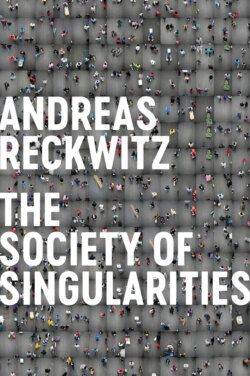Читать книгу Society of Singularities - Andreas Reckwitz - Страница 30
Premodern Societies: The Fixation and Repetition of the Singular
ОглавлениеPremodern societies include both archaic (that is, preliterate) tribal societies and traditional (that is, high-cultural) societies. In archaic societies, the relation between the logic of the general and that of the particular can be described as one of types and idiosyncrasies that is defined by the pronounced difference between the profane and the sacred.1 Archaic societies, which are distinguished by the great stability of their social structures, are essentially identical with a life-world defined by customs and complex typifications that form the basis for a social logic of the general. In part, the practices of these societies were already instrumentally rationalized in the sense of techne. Everyday typifications, however, left some room for similarities and a lack of clarity – and thus for idiosyncratic subjects, objects, and collectives. Yet it would be an anachronistic misunderstanding to regard these premodern idiosyncrasies as valued or even as systematically produced singularities. It is rather the case that archaic societies – perhaps more than any other social form – created space for people to view idiosyncrasies with outright indifference.2
At the same time, however, and in the background of this profane and quotidian life-world, sacred cultural practices were also developed that have fascinated cultural anthropologists from Émile Durkheim to Michel Leiris and Victor Turner:3 highly affective and valued rituals in which the narrative-mythical and aesthetic-ludic dimensions overlap. In the context of these collective rituals, archaic societies singularized individual artifacts and instilled them with extreme hermeneutic and aesthetic qualities (as in the case of totemism, for instance). Here, too, places could be distinguished as holy; rituals could crystallize into singular performative practices; and, in rare cases, subjects (such as magi) could be experienced as singular as well. The cultural sphere that formed around these ritualized cultural practices was a relatively stable and socially inclusive sacred sphere: the sacred was socially fixed.
The transformation from archaic to (in the strict sense) traditional societies was initiated by the Neolithic revolution. This gave rise to agrarian societies with trans-locally governing central authorities and legal systems. Beyond the rural population, a ruling noble class was gradually formed that developed its own lifestyle. In time, mythical and magical world views were replaced by more strictly regulated religions, which were sustained by an institutionalized Church and clergy that required the medium of writing. To some extent, then, traditional societies involved a process of formal rationalization. At the same time, however, these isolated examples of rationalization rested on the extensive and intact traditions of the everyday life-world.
The culturalization of these traditional societies took place within a triadic cultural sphere, which was composed of segments from religion / the Church, courtly culture / high culture, and folk culture, as in the example of the European Middle Ages. The gradual differentiation between the Church and courtly society involved the institutional division of the hermeneutic-narrative and aesthetic dimensions of culture. Whereas the religious practices of world religions developed complex ontologies and cosmologies, spirituality, and formalized collective rituals, practices of courtly culture were institutionalized that combined sophisticated civility with excessive aesthetic opulence. In the case of both religious and aristocratic culture, culture stood under the directive of the state; it was central and hierarchically organized. Folk culture, however, maintained a degree of independence from both. Especially in urban contexts, singularities overlapped with one another in a complex manner on the level of collectives (in the case of guilds, for instance). In traditional societies, individual places and rural communities could also develop into singularities that – seen from the outside – clearly stand out from others and leave the impression of cultural heterogeneity.
There have been repeated attempts to assign the essence of the traditional cultural sphere to just one of these three segments: for Max Weber, it was religion; for Norbert Elias, it was courtly culture; for Mikhail Bakhtin, it was folk culture – although it seems that the coexistence of all three segments was in fact characteristic of the traditional cultural sphere.4 It was characterized by a combination of singularization and repetition. In this form of society, it is clear that singularity did not entail innovation or creativity. The traditional cultural sphere was oriented toward cultural elements that were not novel but, rather, treasured objects of repetition. This was true, for example, of the canonical texts and rites of religion, of the classicizing art and architecture of codified courtly culture, and of the celebrations and festivals of folk culture.
In traditional societies, as in the case of archaic societies, processes of singularization seem to have been more present on the level of things than on that of subjects. Only rarely were subjects acknowledged to be singular (religious prophets or certain rulers, for instance).5 The singularization of things took place, above all, in the realms of the Church and courtly culture. With the rise of representational buildings, architecture achieved a special status in the production of singularity.6 Singular things therefore acquired a fixed place, where they could develop an “aura” (in Walter Benjamin’s sense). In addition, media-technological developments (writing, image techniques) led to the fact that singular objects were increasingly produced on the level of texts and images. In general, the following can be said about all segments of the traditional cultural sphere: the value of singular entities – religious texts, royal palaces, religious or secular art, festivals – was socially codified and seldom controversial.
